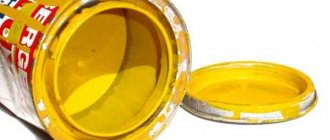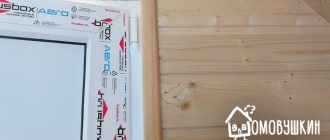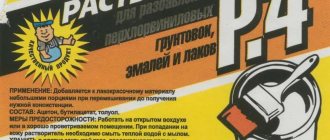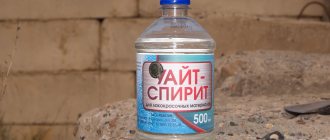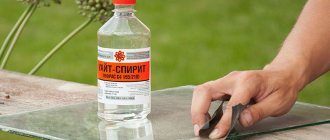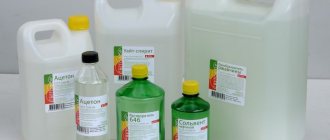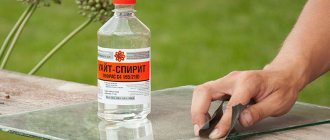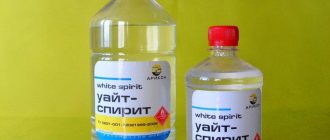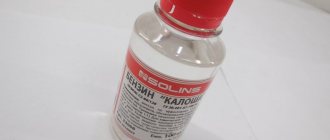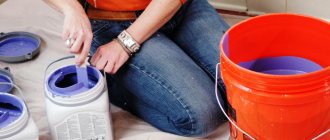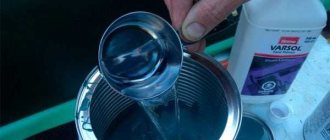Purpose of solvents: which solvent is best for which paint?
The areas of application of solvents and thinners are extensive. When performing repair work, we inevitably deal with solvents for varnish, enamel, and paints. Solvents of rust, concrete, liquid glass, liquid nails, polyurethane foam and other materials are used in construction. Artists constantly use solvents, and in everyday life they help us remove complex contaminants. Our article will help you understand this big topic so that you can quickly answer the question: which solvent is best to use in each specific case.
HOUSEHOLD CHEMICALS
3.1 Windshield washer fluid “Horizon” – designed for washing car windows in the cold season (down to -20 C); made on the basis of isopropyl alcohol.
3.2 Lighter “Taiga” is a universal lighter that works on raw coals and wood. Successfully tested at minus 20 C.
3.3 Products based on sodium hypochlorite - a line of affordable products for keeping your home clean!
Whiteness-gel Universal – designed for bleaching cotton fabrics; eliminating dirt in the kitchen, bathroom and toilet; sewer cleaning; removing germs and odors.
Whiteness-gel for toilet – designed for washing plumbing fixtures and eliminating odors in the toilet and bathroom.
Whiteness Economy is an effective budget assistant in the home; it will help you wash, clean, and bleach.
Whiteness of Needles is an effective budget assistant in a home with the smell of pine needles.
products based on it can work as disinfectants;
We suggest you familiarize yourself with How to wash tape from glass and quickly remove traces of adhesive tape
It is necessary to work with gloves; in case of contact with skin, rinse thoroughly with water.
3.4 Sanitary and hygienic product “Sanitary”
The sanitary and hygienic product ideally removes limescale, dissolves water and urine stone, removes rust and other contaminants, and eliminates unpleasant odors. The product can be used for sinks, ceramic tiles, and for cleaning and disinfecting toilets.
Solvent and thinner: what's the difference?
The terms "solvent" and "diluent" are often used interchangeably. However, there is an important difference between them. In simple terms, the solvent interacts directly with the film-forming (hardening) component.
For example, gasoline is a popular solvent for oil-based paints. It dissolves the binder so it can thin out paint for application and can remove dried paint stains at the same time.
The thinner does not dissolve the substances that form the film, but can only reduce the viscosity of the composition. For example, water dilutes water-based paint well, but it will not be able to wash off dried paint.
White spirit as a degreaser: nuances, surfaces, recommendations
- Solvent Features
- Areas of application
- What can be cleaned with solvent
- Features of working with solvent
Solvents are actively used not only in industry, but also in the domestic sphere. Their main purpose is to purify materials. The question often arises: is it possible to degrease surfaces with white spirit, and how to do it correctly?
Safety precautions
Given the numerous advantages of white spirit, any work with it must be carried out in compliance with safety precautions.
This applies not only to the use of personal protective equipment (respirator, goggles, gloves), but also to a number of other conditions:
- When working indoors, create conditions for good ventilation. Otherwise, there is a possibility of drug poisoning.
- Pumping and draining of solvent using liquid gases is prohibited.
- Do not store liquid in open containers within easy reach of children.
- Avoid working near open flames and hot objects. The low ignition temperature of white spirit often causes it to ignite when exposed to the sun for a long time.
Areas of application
The properties of the solvent provide a wide range of applications. It is used in the following areas:
- in the production of drying oil and transportation of driers;
- for processing metal surfaces in the automotive industry, technical service centers, auto repair shops;
- in construction, for creating mastics;
- in everyday life for carrying out repair work.
The solvent is able to instantly clean the material from glue and is used as a fuel equivalent for burning kerosene. White spirit is used to change the consistency of coloring compositions and achieve the required degree of viscosity. When mixed with drying oil, primers or paints, it provides an increase in the volume of the base material without changing the technical characteristics and quality of the coating.
We wrote about metal degreasing here.
What can be cleaned with solvent
When used on metal surfaces, it does not corrode paint or damage the substrate. The composition is neutral to metal, non-hazardous. White spirit easily copes with bitumen, mastic, paint and varnish residues, lubricating coolants, and conservation oils.
The question often arises, which is better - kerosene or white spirit? The second option is considered a light grade of kerosene. Unlike the first composition, this solvent is less aggressive.
It is often used for degreasing a bathtub before covering it with enamel, and for processing car body parts. Experienced craftsmen have long abandoned acetone and gasoline when preparing to paint metal, preferring white spirit as a degreaser.
Analogs
White spirit is considered the most affordable and popular means for thinning paints, degreasing and cleaning surfaces. It is permissible to use other means, knowing what can replace White Spirit. Preference is often given to other petroleum distillation products: gasoline, turpentine, kerosene.
One of these is gasoline, which dilutes paints, bitumen, and mastic well. The flammable material effectively combats greasy stains on metal and plastic and improves the adhesion of the material before gluing.
To dilute alkyd and oil paints, you can choose turpentine. In its pure form, it removes old paint stains.
Several other analogues:
- solvents R-4A, R-5, R-5A, R-12; R-4A is closest to white spirit in composition and properties; R-4 solution contains butyl acetate, which is incompatible with enamels of the XB-124 type;
- solvent - instantly dissolves paints and varnishes, dries quickly and forms a glossy surface;
- FAS-104 is a powerful product used to clean metal surfaces, including those with corrosion (rust).
Features of working with solvent
Degreasing with white spirit is as simple as possible. To do this, you need to take a sponge or rag, moisten it a little in the liquid, and wipe the area to be treated. There is no need to completely saturate the material. Further work is carried out after the surface has dried.
The compositions of white spirit and R-646 are often confused. This is not the same thing; there are differences between solvent 646 and white spirit. They are produced under different GOST standards and have slightly different areas of application. More often, R-646 is used to dilute nitrite-based paints and enamels, and white spirit is used for oil-based compositions, varnishes, and putties.
It is important to follow safety precautions when working with these substances. If they are violated, symptoms of drug intoxication may appear, so protective equipment must be used.
How to remove a pungent odor?
No matter how good the effect of white spirit is, many people refuse it because of the pungent odor. It remains on literally everything the solution came into contact with: hands, clothes, tools.
There are several ways to get rid of it:
- Soak items in warm soapy water . After working with a degreaser for metal, plastic and glass, all clothing must be immersed in a basin of water for at least half an hour and then washed. It is better to use laundry soap, which eliminates the smell of white spirit solvent. Washed items should be rinsed in vinegar or soda solution.
- Treat the skin. Hands and other parts of the body that have come into contact with white spirit should be thoroughly washed. You can use antibacterial soap, a vinegar solution (1:1 proportions), or an infusion of lemon peels.
- Resort to natural absorbents. It is recommended to leave some coffee beans, baking soda or potato starch in the room or car. After some time, it is enough to collect the remaining substance with a vacuum cleaner.
- Ventilation and wet towels. If degreasing or cleaning work was carried out at home, be sure to ventilate the room. You can hang a few wet rags and use natural flavors (oils, herbs). It is not advisable to use perfume, as the unpleasant odor will only intensify.
Nefras is often used to remove stains on furniture, carpets, and flooring. The unpleasant smell may remain for a long time, but there is a way out - sprinkle the surface with crushed coffee, citrus zest, and soda. It is advisable to wash textiles with soap or powder.
What is white spirit
White spirit is one of the organic solvents that is obtained by direct processing (distillation) of oil. The name of this solvent is a transliteration of the English name - white spirit, which literally translates as “white spirit”. It is a clear, slightly oily liquid. It belongs to substances with a low level of danger (group 4), but with prolonged inhalation of vapors, symptoms of poisoning may appear.
White spirit contains a significant amount of volatile substances (according to GOST 3134-78 no more than 16%, according to TU - as you wish), which gives it a specific smell. To reduce discomfort, substances that smell more pleasant are added. It’s difficult to say that this improves the situation, but...
There are different packaging
In fact, white spirit is one of the types of kerosene (light fractions) or dehydrated purified gasoline. It contains a larger amount of volatile and “aromatic” substances, so it is rarely used as fuel, since it produces little heat.
White spirit does not have a specific formula, since it is performed by distillation and the composition depends on the source raw material. Some types - with additional purification - have a weak odor due to the greater number of purification steps. The odorless solvent is usually of Western origin. It has a more complex cleaning technology, but its dissolving power is lower and its price is higher. Nevertheless, it is also quite popular, since the absence of odor is often important - when working with paints for a long time, for example.
Release form
The wash is packaged in bottles of 0.5, 1, 5 and 10 liters (container weight is indicated in kg), and the packaging material differs. Thermoplastic is suitable for small volumes, and for large bottlings, low-pressure polyethylene canisters are chosen.
The composition is produced in glass or plastic containers with polyethylene stoppers.
In the future, packaging in wooden, plastic or cardboard boxes is possible. The product manufacturer reserves the right to use any type of packaging that meets safety standards and regulations.
Application area
White spirit is used mainly as a solvent for any fractions of oil, sulfur compounds, nitrogen, and oxygen. It can also dissolve vegetable fats. The ability to dissolve fats is used if it is necessary to clean the surface before priming, applying paint, etc. It is actively used before applying paint and varnish coatings (LPC) to metals.
Before painting metal, it should be treated with white spirit - the paint will stick better
For cleansing
You should not use this solvent to clean fabrics or highly absorbent surfaces - you will struggle with the smell for a long time and persistently. It is very difficult to defeat him. The most effective method is treatment with hot (superheated) steam. So that the substances that give the smell heat up and evaporate. It is worth knowing that white spirit begins to boil at 165°C, and evaporates completely at 200°C. If it is possible to heat the surface to a similar temperature, the volatile substances evaporate and the smell becomes less.
There are no such problems with smooth surfaces - it evaporates instantly. Outdoors or in a well-ventilated area, the smell is faint. During renovations and construction, mineral spirits can be used to remove old paint, putty, oil and grease stains. Another useful property is that it removes well the glue that remains after removing the tape and rosin stains.
No need to pour solvent - slightly moisten the edge of the cloth or sponge
White spirit is also used to degrease natural leather. Since there is no chlorine in the composition, it does not change the properties, color and texture. It can be used to protect or “treat” wood from mold and fungi. The liquid penetrates deeply into the pores, destroying the source of damage. In addition, the paint adheres better and consumption is reduced. That is, white spirit can be used as a primer and antibacterial protection for wood.
As a solvent
Despite the fact that the dissolving ability of white spirit is average, it is often used for diluting many compositions to the desired consistency. In this case, a solvent is introduced into the composition, and not vice versa. Mix thoroughly until smooth. As a solvent, white spirit is used with the following compositions:
- oil paints;
- antibacterial impregnation for wood;
- drying oil;
- alkyd enamels;
- alkyd varnishes;
- bitumen mastics;
- rubber mastics.
It is better to work with gloves, use a wooden stick
When combined with paint, white spirit reduces its viscosity. The composition is better applied and distributed, consumption is reduced. But it is worth remembering that after drying the surface will be glossy. If you need a matte finish, look for another solvent.
Dilute to a more liquid state with white spirit and putty. But only those that have an appropriate basis:
- ML - melamine,
- M - oil- and alkyd-styrene;
- PF - pentaphthalic;
- MP - urea;
- VN - divinylacetylene.
White spirit is popular among car owners as a means of removing car mastics. Cleans any bitumen-based compounds and oil shale mastics. Well removes lubricants that are used to treat parts to protect against corrosion (car preservatives). Just remember that the liquid is highly corrosive. That is, you should not allow prolonged contact with the surface. If a puddle has formed, it must be quickly removed and the area wiped dry.
Easily removes stains from car paintwork
GLOSSARY:
Paintwork solvent (solvent) is a single- or multicomponent liquid that evaporates under certain drying conditions and completely dissolves the film-forming substance of the paintwork material.
Paint thinner (diluent) is a single- or multi-component volatile liquid, which, not being a paint solvent, can be used in combination with a solvent without having a harmful effect on the properties of paints and paintwork materials.
Purpose: for dissolving film-forming agents, for diluting coatings to a consistency that allows them to be applied to the surface to be painted, as well as for preparing and degreasing the surface before painting, washing tools and equipment.
by composition: petroleum, mixed (multi-component), mono (single-component); organic and inorganic;
by evaporation rate (relative to diethyl ether): highly volatile (15).
Volatility is a quantitative characteristic of the evaporation of a solvent (the higher the indicator, the slower the evaporation occurs). This indicator affects the drying speed of paintwork materials. If the volatility index is very high, then the drying of the paint will take longer or unevenly, and if the volatility index is very low, then the solvent may not fulfill its intended purpose - it will not have time to reduce the viscosity of the paint before its application or there will be problems with the use of spray guns.
Acid number is a quantitative indicator that characterizes the presence of free acids in a solvent. A very important indicator, because The solvent must be neutral, otherwise corrosion of the painted surface may occur.
Coagulation number is a quantitative assessment of the dissolving ability of a solvent or the resistance of a paintwork base to sticking when diluted with a solvent.
Flash point is an indicator that characterizes the ease of ignition.
Properties and characteristics
As already mentioned, the characteristics and properties of white spirit are standardized: GOST 3134-78. But finding a solvent made in accordance with GOST on sale is very difficult. Most of them are produced according to specifications, which set out their own rules. In particular, the maximum content of volatile substances changes.
White spirit called Nefras is produced according to TU 0251-009-51758336-2008
For example, Nefras-S4-155/205 is widely used. Its quality characteristics are lower than those required by GOST. But it is produced according to specifications, which does not contradict the law. The list of GOST requirements is given in the table.
Characteristics of white spirit according to GOST
Pay attention to such characteristics as flash point. According to GOST it is +33°C. This means that when heated to this temperature, a fire is possible. So you need to be very careful when using and storing. There is one more feature - the liquid accumulates a static charge. Therefore, the container is plastic or glass.
Composition labeling
The container for transporting packaged white spirit must be marked. The packaging is marked with a sign corresponding to the hazard class, classification number 3319. In addition, a mark is made in accordance with state standard 14192: “Fragile. Caution" and "Top".
Compliance with GOST
The composition of white spirit must meet the requirements of GOST 3134-78 dated January 1, 1979. Its effect extends to the substance nefras C4 155/200.
Technical requirements affect not only production, but also the raw materials used, technology, packaging and packaging of the product. According to regulatory documents, the manufacturer undertakes to guarantee that the product complies with this standard.
Storage and use
White spirit is a flammable substance (category 2), auto-ignition temperature is 270°C. Vapors mixed with air create an explosive mixture. Given these features, pay special attention to the storage location. This solvent should be kept in a dark, cool, ventilated room, out of reach of sunlight. There should be no heat sources nearby, including heating devices. The shelf life is usually indicated on the can, but it is not important. If there is liquid inside and not jelly, it can be used.
Packaged in plastic bottles and canisters
When opening and operating, the following requirements must be met:
- Work outside or in a well-ventilated area.
- It is unacceptable to be near open flames or sources of sparks.
- When opening the container and mixing the compositions, do not use devices that can create a spark.
- White spirit begins to evaporate at a temperature of +20°C. To ensure quick drying of paint, mastics, putty, you need to work in the warm season or in a warm room.
- If solvent is spilled in a room, open windows and doors, collect as much as possible, and remove it from the room. Wipe the area where white spirit was spilled with a rag. To remove grease stains, you can use detergents that dissolve fats. If you spill it on the street, fill the puddle with sand, which you then take out.
- In case of fire, do not extinguish it with water. Use foam, sand, powder, felt.
According to the degree of impact on the human body, it is classified as a substance with low danger. In case of contact with skin, it can cause burning, dermatitis and allergic eczema. Therefore, it is better to avoid even short contact. The best thing you can do is wear gloves. If you have to work indoors for a long time, it makes sense to wear a respirator.
Precautionary measures
The advantages of white spirit (nefras-C4-155/200) compared to other solvents are low toxicity - characterized by class 4 (low-hazard substances) in terms of harm to the body, no serious consequences in case of accidental contact with skin, and low fire hazard. It is a flammable liquid and is flammable.
When working with the substance, you must use personal protective equipment and observe fire safety.
Rubber gloves should be worn. If it comes into contact with exposed areas of the body, the diluent dries the skin and, with prolonged exposure, can cause skin irritation and dermatitis.
The room in which work is carried out must be ventilated, with access to fresh air. Concentrated solvent vapors are a potent agent and, when inhaled, can cause headaches, hallucinations, anesthesia and other negative effects on the central nervous system.
It is unacceptable to store and use white spirit near an open fire, or to use tools that can create a spark when opening transport packages.
It is prohibited to pump and discharge the product in production processes using compressed gas.
In the event of a white spirit fire, use any fire extinguishing agent, with the exception of water.
Which is better: ours or imported?
Despite the fact that the production technology is the same, imported white spirit has a weaker odor (and higher prices). This is due to the fact that the product goes through more purification stages, which remove volatile compounds. It’s good - work is easier, there are no headaches and all other symptoms.
Each has its own advantages and disadvantages
The bad thing is that during the cleaning process the dissolving power decreases. This means that fluid consumption will be greater. This is when we talk about adding to paints or mastics. The second point is that the stains will be scrubbed off worse. This is if you use the substance as a stain remover. On the other hand, if you try to remove a stain from fabric with low-purity white spirit, it will be extremely difficult to get rid of the smell (note that repeated washing does not help). It’s clear that the less odorous the liquid, the easier the problem is to solve. Perhaps for this reason, some manufacturers produce this type of solvent in several degrees of purification (for example, Tikkurilla - with blue and yellow labels). Different tools for different tasks.
Impact on humans
It is recommended to wear gloves when working with white spirit and to be in a ventilated area.
- Inhalation of vapors
. Vapor concentrations above recommended levels cause eye and respiratory irritation and may cause headaches, dizziness, anesthesia, or other adverse effects on the central nervous system. - Inhalation
. Small amounts of liquid inhaled through ingestion or vomiting can cause bronchopneumonia or pulmonary edema. Minimal toxicity. - Skin contact
. Low level of toxicity. Frequent or prolonged contact can degrease and dry the skin, resulting in irritation and dermatitis. - Contact with eyes
. Causes lacrimation and superficial irritation, but does not damage eye tissue. - Chronic exposure
. White spirit may contain 0.1 - 1% ethylbenzene. The International Agency for Research on Cancer has classified ethylbenzene as "probably carcinogenic to humans" and placed it in Category 2B, which is based on sufficient evidence of carcinogenicity in experimental animals but insufficient evidence of cancer in unprotected humans.
Symptoms of poisoning
White spirit has a toxic effect on the human body. Prolonged inhalation of the vapors of the composition can lead to poisoning, as evidenced by severe headache, dizziness and nausea.
Often after working with the nefras mixture, drowsiness and weakness, pale skin, and lacrimation are noted. People prone to allergic reactions and skin diseases may develop a rash on their body.
If even 1-2 symptoms are present, you must stop working immediately. If your condition worsens, be sure to seek medical help.
Solvent or white spirit - which is better?
When comparing solvent and white spirit, you must immediately make a reservation that these are two solvents with similar properties, which are produced mainly from crude oil by distilling it in cracking columns at oil refineries. Without access to oxygen, at temperatures from 130 to 150C, hydrocarbons are evaporated, from which a solvent (solvent) is produced. In the same cracking columns, mixtures of hydrocarbons called white spirits are evaporated at temperatures from 155 to 200C. Aromatic hydrocarbons are evaporated from oil at low temperatures and in solvent form up to 56% of the total mass. The mass of such hydrocarbons in white spirit should not exceed 16%.
In addition to oil cracking, the production of solvent is established when producing coke from coal, when light aromatic fractions of hydrocarbons are released when heated in the form of coke oven gas, collected when passing through an exhaust pipe, condensed while passing through coolers, and the output is xylene, quite suitable for consumption, toluene and solvent. This coke oven gas contains up to 60% light aromatic hydrocarbons. Due to the higher content of aromatic hydrocarbons, the solvent, unlike white spirit, has a sharper characteristic odor, which evaporates quite quickly, however, when working with the solvent for a long time in a closed, unventilated room, it can cause a headache and even hallucinations in a person.
The content of hydrocarbons of different volatility gives both solvents slightly different properties, for example, solvent may have a yellowish tint, white spirit is always transparent, solvent dries within 10-20 minutes, white spirit dries within 1-2 hours, solvent gives paints a glossy surface , and White Spirit makes the paint matte with an additional film on top. Solvent has found application not only for diluting paints, it is also actively used for cleaning metal parts (including car bodies) before painting them. White spirit is more actively used by paint manufacturers and consumers at home. Similar properties include the ability of both solvents to dissolve oil paints and fats. In addition to oil paints, the solvent dissolves nitro paints well. Both solvents are used in the production of glyphthalic, pentaphthalic, alkyd and bitumen paints and varnishes, when removing old dried paints and when removing grease stains before painting. Due to its low odor and low drying speed, white spirit is more actively used in the production of paints. Using solvents, rubbers, bitumens and polyesteramides are dissolved. Sometimes solvent is used to obtain poison from rats and beetles, but this is rather an exception.
Both solvents are flammable substances with a low flash point, and both have the ability to accumulate static electricity, which can cause an explosion. The density of the solvent is higher than the density of white spirit, and they are 0.86 and 0.79, respectively.
Despite assurances of development and improvement of the quality of both solvents, at the moment not a single oil refinery in the Russian Federation produces solvents that comply with GOST 1978 and 1979, which determine their regulatory compliance. This happened for a number of reasons:
- GOST allowed the presence of aromatic hydrocarbons, which made both solvents so odorous that they did not find their use abroad, that is, they are not sold for export. Western analogues do not have the smell and color, which is provided for in the regulations of these countries, so our solvents are very inferior to them.
- Increasing consumer demands for solvents has led to an increase in the flow of imported solvents. Transparent and completely odorless solvent produced at coal processing plants in Alsace and White Spirit distilled in Norway greatly displaced the production of domestic solvents, making its production unprofitable.
- The deepening of the oil refining process created conditions when it became possible to distill the fraction of solvents and white spirits with a boiling point from 120 to 200C into more expensive benzenes and gasolines, replacing solvents with inexpensive orthoxyols and toluenes. Today, the production of solvent and white spirit according to GOST standards is not economically profitable, and all oil refineries that sell solvents produce them based on their own specifications. Such solvents do not have the density of the declared solvents and have overly strong odors.
- Modern developments in chemistry have made it possible to obtain solvent and white spirit by simply mixing various hydrocarbons. As a result, it turned out to be much easier and cheaper to achieve the properties of solvents by adding various hydrocarbons than to carry out complex and costly oil refining processes.
- Many manufacturers are trying to replace solvent and white spirit with various kerosene-based solvents. Such attempts are quite successful and will probably soon make it possible to completely abandon the centuries-old dependence on petroleum solvents.
Use of solvents
The content of the article
- Solvents
- Solvents or thinners
- Thinners
- Table with different types
All paint and varnish materials are usually divided into basic, intermediate and other. Representatives of the intermediate category are thinners and solvents. Solvents are commonly used at various stages of the paint and varnish industry. For example, they are used in paint and varnish production and are needed as a viscosity regulator.
The definition of these substances is as follows: solvents are low molecular weight volatile liquids with low boiling points. They are strong and weak: the first are characterized by the fact that with them a given polymer forms a single system in any concentration range and wide temperature range.
High-quality solvents for paint and varnish materials have the following qualities: inertness (they do not react with paint and varnish materials), volatility (for complete evaporation during the drying of the paint and varnish layer).
According to the degree of activity, solvents are divided into three groups:
- higher
- average,
- small
Simple solvents:
- turpentine,
- ethyl acetate,
- acetone,
- amyl acetate,
- dichloroethane,
- White Spirit,
- Technical coal solvent.
They are organic in their pure form and are used to dissolve films or prepare various mixtures.
Tips for choosing
It should be remembered that each type of coating requires a very specific type of solvent to operate. More precisely, there are specific types of reagents for fat, glue, oil, paint, correction fluid, gypsum, drying oil, cement grout, primer, rosin and other paints and varnishes. Therefore, the correct selection of the product is a guarantee of high-quality coating, since it ensures the homogeneity of the mixture, the absence of disintegration, and easy and quick work with it. Knowing the technical characteristics of a product helps in its selection.
The volatility of the reagent directly affects the quality of the film formed by the paintwork material
The likely level of volatility of a reagent can be inferred from its boiling point. The smaller it is, the higher this property is, and vice versa
The main evaluation criteria are minor deviations in color, density, presence of particles and sediments. It is better not to buy such reagents.
Reagents that dissolve paint materials are selected by manufacturers based on the speed and uniformity of the evaporation process. The cheap components found in them disrupt these processes.
For example, the acetone in Reagent 646 is too volatile, preventing optimal film drying. Due to extremely rapid evaporation, the formation of a surface film occurs too quickly, which, in turn, prevents the release of residual volatile components from the deep layers. The result is “boiling,” loss of shine, and poor film quality.
When choosing and working with reagents, it is necessary to take into account such a feature of the product as the level of toxicity.
In this context, 3 indicators are distinguished:
- Maximum permissible concentration in the work area (MPC) is an indicator reflecting the permissible degree of saturation with toxins.
- Semi-lethal dose coefficient. For example, “LD50” means that when the body receives a product of a certain concentration (mg), the probability of death is 50%.
- The average concentration of toxic evaporation emitted by the reagent until final drying (determined using a special table).
Types of solvents
White Spirit
Solvent gasoline is a product of petroleum distillation. Its physical characteristics are as follows: a transparent, colorless liquid. Application area: dissolution of nitro paints and some types of resins, as well as oil paints. In the case of paints and varnishes, the dosage of white spirit must be limited to 10% of the total mass of the paint and varnish material.
Turpentine
A colorless, often transparent, sometimes with a reddish or dark red tint, a liquid that is usually used to dilute paints and accelerate the drying of paintwork. Turpentine is mainly used to dilute oil paints. If you choose between purified and unrefined turpentine, then for painting surfaces you should pay attention to purified turpentine.
Turpentine is highly flammable. Wood (unrefined) turpentine is obtained by dry distillation of wood; gum turpentine - through the distillation of coniferous resin. The first must undergo additional processing, due to which the coloring components contained in wood turpentine will disappear from the composition of the solvent.
To understand whether you are satisfied with the quality of turpentine, you need to mix drying oil and turpentine in equal proportions onto the surface. If after a day a strong film remains on the paintwork, the quality of the solvent is undoubted.
Gum turpentine, or, as it is also called, turpentine oil, is more environmentally friendly in contrast to wood turpentine: it is distinguished by a calmer smell and lightness.
Turpentine is also used for degreasing coatings, despite the high cost of this solvent, which is justified by the high quality of the working material.
Acetone, amyl acetate, ethyl acetate
Solvents that are used in the case of nitro paints. Since these substances mix quite easily with water, it is necessary to ensure that it does not get into them: this can cause whitening of the transparent film. If you add butyl alcohol solvents to the composition of these substances, the gloss of the varnish film will significantly improve.
Solvent
Technical coal is a mixture of aromatic hydrocarbons that are obtained in coke production during the rectification of purified fractions of crude benzene. Physical characteristics of the solvent: it is a transparent, colorless liquid, it is available in three grades - A, B, C, which differ in the following parameters: boiling point, density, small fluctuations in the content of chemicals such as sulfur and phenols.
Solvent is a high-quality paint solvent, however, due to its toxicity, solvent is not as popular as turpentine. Solvent is used only for diluting pentaphthalic and glypthal paints.
Dichloroethane
The next solvent that needs to be mentioned is. This colorless, slightly flammable liquid has a chloroform odor and also tends to turn yellow when exposed to sunlight. Precautions when using this thinner: a mandatory condition when working with this substance is the use of rubber gloves, since the thinner, due to the specific chemical composition, can significantly affect the skin of your hands.
Driers
These are special additives that help improve the decorative effect, as well as the water resistance of the finished dye composition. In addition, they can significantly reduce the amount of time required for drying oil paints, varnishes, drying oils, and oils. However, these additives have a rather serious drawback: when used, the paint coating becomes extremely fragile, and therefore it is recommended, if possible, to do without their use when treating the surface.
Ideal solvents for some types of resins are substances such as gasoline and kerosene. They are also used in washing hands contaminated with paint, as well as in cleaning work tools.
Operating principle
To understand this process, you need to know which component is the main one in a particular coloring composition. Consequently, the solvent is selected with a similar composition. When you add it to dried paint, it will complement its composition and replenish the evaporated part of the base. Thus, you will be able to achieve almost its original condition. The main thing is to thoroughly mix the components together, reaching to the very bottom, so that the solvent does not float on the surface and the composition becomes uniform in thickness.
simple rules
- The dishes in which you will do the work must be clean. No dried paint fragments from previous uses and no small debris. Rinse it with water and wipe dry.
- The most suitable containers are those that have a cylindrical shape with smooth walls. In such a vessel you can move the components as evenly as possible.
- If we are talking about paints that must be diluted with water, then its part should be no more than 10% of the total mass.
- In alkyd enamels that will be used for exterior work, it is necessary to add no more than 3% of the total amount of liquid.
- For interior work – no more than 5%.
If you add too much solvent, your paint will not adhere and will simply run off the surface being treated. This is especially true for vertical planes, on which drips instantly form. At the same time, the performance indicator and service life of the coating are reduced. Let's take a closer look at the most common types of interior paints and the types of solvents suitable for them.
Solvents and thinners
Difference between solvents and thinners
Thinners
- these are solvents that are not capable of dissolving a given polymer alone, but when introduced into a polymer solution do not destroy its structure.
In fact, mixtures of solvents are very often used; their alternative name is numbered solvents.
Thus, solvent R-4 (contains acetone and toluene) is suitable for dissolving and diluting alkyd paints and enamels based on chlorinated polymers.
Water-based paints and varnishes can only be diluted with water. You also need to remember that water must be poured gradually and in very small doses, otherwise the viscosity will decrease too much.
Characteristics of solvent 646
Among solvent masters, the most famous is solvent 646 (P-646).
It was first made in the 20th century. At first it was used for diluting nitro-varnishes and nitro-enamels; its versatility was discovered much later, and it began to be used in diluting paints and varnishes to working viscosity, in the cleaning procedure for painting equipment and working tools. The many components that make up this solvent play a significant role in the ability to dissolve most organic substances.
Solvent 646 is a colorless/slightly yellowish liquid and has a specific odor. The percentage of the following substances is included in its composition: toluene (50%), ethanol (15%), butyl acetate (10%), butanol (10%), ethyl cellosolve (8%), acetone (7%).
Solvent 646 is a fairly strong solvent, therefore, when using it as a working substance, it is necessary to observe safety precautions and be extremely careful when using it.
After drying, the paint coating acquires additional shine.
Solvent 649 is used to dissolve nitrocellulose-glyphthalic film formers.
The choice of thinner depends on the working situation; the main determination parameters are the type of paint and varnish material and the ambient temperature during application of the material.
FAQ
4.1 Difference between degreaser and acetone
Application: used for dissolving various film-forming substances.
Materials: any surfaces (metal, wood, plastic) can be treated with a degreaser, and only hard and durable surfaces (slightly corrosive surfaces) can be used with acetone. Acetone should not be used on plastic or aluminum surfaces.
Odor: Acetone has a strong odor, while degreaser is practically odorless.
Use: The degreaser is less aggressive, so it can be used with a trigger.
4.2 Degreasing abilities of petroleum solvents
The more homogeneous the oil fraction, the more uniformly the solvent will evaporate, therefore the degreasing ability increases from kerosene to degreaser: kerosene → white spirit → degreaser.
4.3 How to choose a solvent
To choose the right solvent, you must carefully read the paint manufacturer's recommendations on the packaging. If you want to use a solvent not recommended by the manufacturer or an analogue, then first test the solvent on a small volume of paintwork.
We suggest you familiarize yourself with White Spirit: how to get rid of odor
4.4 How much solvent to add to paintwork materials
The solvent is added in small portions with stirring until the desired viscosity is achieved, but not more than 20%.
Types of thinners
S10 Thinner for PE materials
This thinner is used to thin polyester varnishes to obtain the desired viscosity. It is a transparent and colorless liquid. The main advantage is that it dries quickly.
S12 Thinner for NC materials
Area of application: dilution of NC varnishes and primers until the required working viscosity is obtained. It is also a clear, colorless liquid. Has an average drying speed.
S30 Dye thinner
Used when diluting dyes in order to obtain a working concentration of the material.
Physical characteristics: colorless, transparent. Has an average drying speed.
